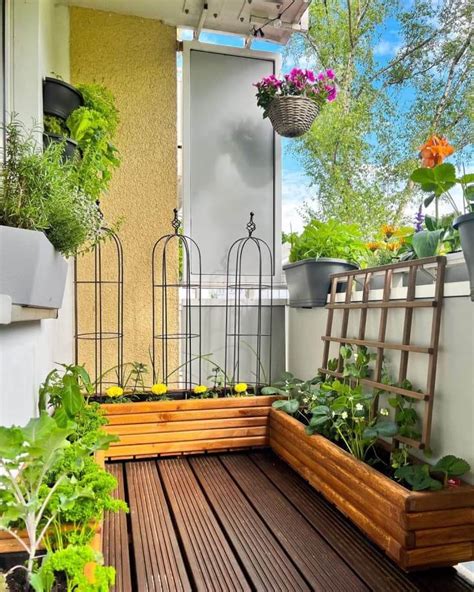Transform Your Balcony Garden Into a Bee Sanctuary: A Step-by-Step Guide
In an urban environment, a small balcony garden can play a critical role in supporting bee populations. As pollinators, bees are essential for biodiversity and food production, and creating a bee-friendly garden on your balcony can be both rewarding and beneficial. Whether you are an experienced gardener or a beginner, this guide will take you through the process of transforming your balcony into a haven for pollinators, using container gardening techniques to support urban biodiversity.
Introduction
Urbanization has significantly reduced the availability of natural habitats for bees. Many urban dwellers might feel they don’t have the space to contribute to environmental efforts. However, with a little creativity and the right gardening tips, even a small balcony can support bees. This guide aims to provide you with practical advice on balcony gardening to encourage pollinators, offering step-by-step instructions on how to create an outdoor space that contributes to biodiversity while enhancing your home’s outdoor beauty.
Key Concepts
- Pollinator Support: Choosing plants that provide food and habitat for bees.
- Container Gardening: Utilizing pots and planters to maximize small balcony spaces.
- Seasonal Planting: Ensuring a variety of plants bloom throughout the year to provide consistent food sources.
- Biodiversity: Creating a balanced garden ecosystem that supports not just bees but other beneficial insects.
Historical Context
Balcony gardens have long been a staple in urban environments, but they were traditionally focused on aesthetics. The recent rise in urban gardening reflects growing awareness of environmental issues, particularly the declining bee population. Historically, green spaces have been seen as luxurious; today, they are vital spaces for fostering biodiversity in cities. Urban gardening efforts are no longer just about decoration; they are about supporting ecosystems.
Current State Analysis
Currently, the global bee population is in decline, primarily due to habitat loss, pesticides, and climate change. Urban areas, despite their high density, offer untapped potential for pollinator support. By turning underutilized spaces such as balconies into bee-friendly gardens, city dwellers can actively participate in mitigating this crisis. The rise of container gardening makes it easier than ever to cultivate pollinator-friendly plants in confined spaces.
Practical Applications
Here’s a step-by-step guide to help you set up a successful gardening strategy for your balcony, focused on attracting and supporting bees:
- Plan Your Space: Assess the size of your balcony and sunlight exposure. Most bee-friendly plants thrive in direct sunlight.
- Choose the Right Plants: Opt for native flowers and herbs such as lavender, thyme, and sunflowers. Use a mix of perennials and annuals to ensure year-round flowering.
- Use Diverse Containers: Incorporate containers of various sizes to accommodate plants with different root systems. Vertical gardening can maximize space.
- Provide Water Sources: Bees need access to water, so include shallow dishes with water and small stones for landing spots.
- Avoid Pesticides: Stick to organic gardening practices to keep your garden safe for bees.
Case Studies
| City | Type of Balcony Garden | Pollinator Impact | Notable Features |
|---|---|---|---|
| New York | Herb Garden | Increased local bee sightings by 25% | Small, primarily container gardening using vertical space |
| London | Flowering Balcony | Attracted three bee species not commonly seen in the city | Mixed-use balcony with planters and hanging baskets |
| Tokyo | Minimalist Garden | Improved urban biodiversity in the surrounding neighborhood | Low-maintenance plants, focus on native species |
Stakeholder Analysis
Several groups benefit from creating a bee-friendly balcony garden:
- Local Pollinators: Urban bees benefit from a reliable food source and shelter.
- Gardeners: Individuals can take pride in their contribution to the environment while enjoying a beautiful garden.
- Community: The broader urban community benefits from increased biodiversity and pollination, which supports local green spaces and food sources.
Implementation Guidelines
To create a sanctuary for bees on your balcony:
- Choose Bee-Friendly Plants: Research native plants that thrive in your climate and require minimal maintenance.
- Optimize Watering: Install a drip system or use self-watering containers to ensure your plants are hydrated without overwatering.
- Create Shelter: Consider adding a small bee hotel or leaving some plants unpruned to create natural habitats for solitary bees.
- Monitor for Success: Regularly check which plants attract bees and adjust your garden accordingly to support their needs.
Ethical Considerations
When creating a pollinator support garden, it is crucial to consider the broader environmental impact:
- Avoid Exotic Species: Non-native plants may attract bees, but they can outcompete local species and disrupt the ecosystem.
- Sustainable Practices: Use organic materials, avoid pesticides, and recycle water where possible.
Limitations and Future Research
Despite the benefits, balcony gardens have limitations. Space is often constrained, which limits the number of plants one can grow. Future research could explore innovative methods for optimizing space use in urban gardening, such as integrating smart technologies for plant care or using more advanced vertical gardening systems. Additionally, long-term studies on the effectiveness of these gardens in enhancing urban biodiversity are needed to substantiate anecdotal evidence.
Expert Commentary
According to urban gardening specialists, the key to creating a successful bee-friendly balcony is diversity. “Bees need a variety of plants that bloom at different times of the year,” explains Dr. Sarah Linden, an expert in urban ecosystems. “Balcony gardens may seem small, but they can have a significant cumulative impact on the urban environment.” Further insights from Professor Marco Rivera suggest that even small interventions can dramatically improve biodiversity. “Incorporating just a few native species can make a world of difference for local pollinators.”


